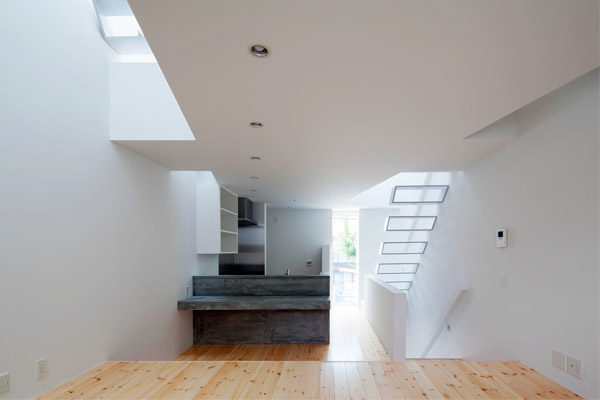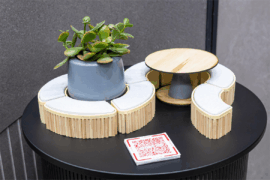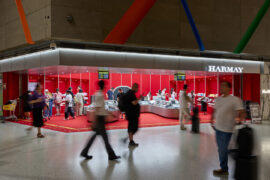In a small Osaka district where houses, factories and buildings coexist without real harmony, architect Kenji Ido of Ido, Kenji Architectural Studio, discovered a way to invite the light. By Thomas Tran.

February 24th, 2014
In a style reminiscent of Japanese origami, House in Tamatsu and House F are both Ido’s answers to two separate briefs desperate for some natural lighting.
“I start with probing the architectural language currently considered to be natural” says Ido, “such as a wall or window, and explore the meaning behind these elements for every project”.
The three-storey house in Tamatsu features a unique skewed upper storey that strategically elevates its position over the prying eye of neighbouring buildings.
“The client requested the family room to be as large as possible without pillars or road-bearing walls, and that natural light come into the house,” explains Ido.
By rotating the second floor 14 degrees and capitalising on the interstitial voids created by the shift, ample sunlight trickles down into the family room from the top storey.
The main bedroom and wet rooms are positioned on ground level, with hollow white boxes for stairs guiding up into the family room on the first storey. Ido carefully considered the client’s lifestyle and family of four in his approach to the brief.
The second storey features the children’s room, which leads up onto the open roof terrace.
Likewise, House F offers a visually narrow yet considered design with a striking timber façade.
Ido planned the three-storey home for a couple, with key focus on the minimalistic front driveway and small garden at the rear.
“The client requested a garden in the south side of the site, and decided to make [the] building three storeys to secure required rooms,” mentions Ido.
The profusion of wide windows, coupled with crisp white walls, provide the necessary illusion of brightness and openness in an-already restrictive space.
A traditional Japanese room replaces the bedroom on ground level and offers a sleeping area that extends out into the garden.
Pine is extensively utilised throughout the house, from flooring to doors to bookshelves. “[It’s] aimed as a quiet, soft space with the wood and the paint-finished walls,” adds Ido.
With a total floor area of just 95 and 117 sqm respectively, House in Tamatsu and House F both succeed in design under Ido’s tenacious yet practical vision.
Ido, Kenji Architectural Studio
kenjiido.com
INDESIGN is on instagram
Follow @indesignlive
A searchable and comprehensive guide for specifying leading products and their suppliers
Keep up to date with the latest and greatest from our industry BFF's!

From the spark of an idea on the page to the launch of new pieces in a showroom is a journey every aspiring industrial and furnishing designer imagines making.

For those who appreciate form as much as function, Gaggenau’s latest induction innovation delivers sculpted precision and effortless flexibility, disappearing seamlessly into the surface when not in use.

Merging two hotel identities in one landmark development, Hotel Indigo and Holiday Inn Little Collins capture the spirit of Melbourne through Buchan’s narrative-driven design – elevated by GROHE’s signature craftsmanship.

Spaniard Jaime Hayon recently unveiled his new Gardenia collection for BD Barcelona Design, here he discusses his ongoing journey from artist to becoming one of the most iconic designers of our time
The internet never sleeps! Here's the stuff you might have missed

Kiri Morgan, Director at Nightworks Studio, talks to us about the New Zealand practice’s very own new production space at Lawson St.

With its latest outpost inside Shanghai’s bustling Hongqiao International Airport, HARMAY once again partners with AIM Architecture to reimagine retail through colour, movement and cultural expression.